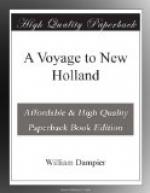We were now standing away for the island Tenerife where I intended to take in some wine and brandy for my voyage. On Sunday, half an hour past 3 in the afternoon, we made the island and crowded in with all our sails till five; when the north-east point of the isle bore west-south-west distance 7 leagues. But, being then so far off that I could not expect to get in before night, I lay by till next morning, deliberating whether I should put in at Santa Cruz, or at Oratavia, the one on the east, the other on the west side of the island; which lies mostly north and south; and these are the principal ports on each side. I chose Santa Cruz as the better harbour (especially at this time of the year) and as best furnished with that sort of wine which I had occasion to take in for my voyage: so there I come to an anchor January 30th, in 33 fathom water, black slimy ground; about half a mile from the shore; from which distance I took the sight of the town.
In the road ships must ride in 30, 40, or 50 fathom water, not above half a mile from the shore at farthest: and if there are many ships they must ride close one by another. The shore is generally high land and in most places steep too. This road lies so open to the east that winds from that side make a great swell, and very bad going ashore in boats: the ships that ride here are then often forced to put to sea, and sometimes to cut or slip their anchors, not being able to weigh them. The best and smoothest landing is in a small sandy cove, about a mile to the north-east of the road, where there is good water, with which ships that lade here are supplied; and many times ships that lade at Oratavia, which is the chief port for trade, send their boats hither for water. That is a worse port for westerly than this is for easterly winds; and then all ships that are there put to sea. Between this watering-place and Santa Cruz are two little forts; which with some batteries scattered along the coast command the road. Santa Cruz itself is a small unwalled town fronting the sea, guarded with two other forts to secure the road. There are about 200 houses in the town, all two stories high, strongly built with stone and covered with pantile. It hath two convents and one church, which are the best buildings in the town. The forts here could not secure the Spanish galleons from Admiral Blake, though they hauled in close under the main fort. Many of the inhabitants that are now living remember that action in which the English battered the town, and did it much damage; and the marks of the shot still remain in the fort walls. The wrecks of the galleons that were burnt here lie in 15 fathom water: and it is said that most of the plate lies there, though some of it was hastily carried ashore at Blake’s coming in sight.
Laguna town lake and country; and Oratavia town and road.




